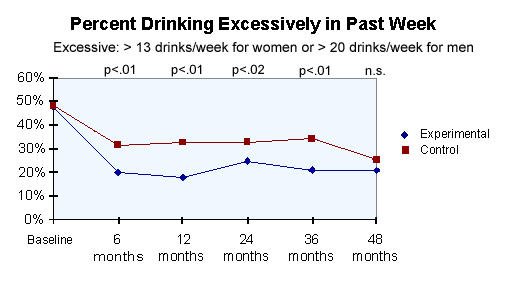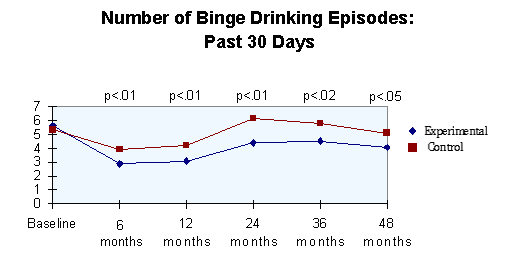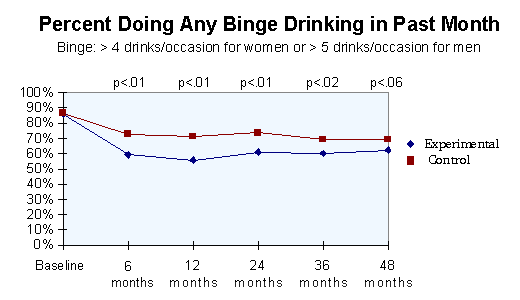|
|
|
In addition to the classic brief motivational intervention studies, there have been a number of studies focused on reducing alcohol use in individual students, utilizing a number of techniques that overlap with brief intervention and motivational interviewing. Other interventions with college students have included:
|
For information on these other interventions, the author refers readers to Larimer and Cronce (2002) which can be found in Supplement 14 of the Journal of Alcohol Studies.
Below is a detailed review of 7 brief intervention studies that are applicable to student health settings.
Study 1
Baer (1992) conducted a study with 132 college students at the University of Washington. Subjects were assigned to one of three groups: alcohol skills group therapy, alcohol skills self- help booklet, and one-hour feedback. There was significant pre- post-reduction in alcohol use in all three groups. Limitations of the study included the absence of a no-intervention control group and poor follow-up rates. The study was conducted in a research setting rather than in a clinical setting.
Study 2
Marlatt (1998) conducted a trial with a sample of 348 high-risk freshman identified prior to starting school. Students willing to participate were either assigned to a no-intervention control group or the intervention group. The intervention group received written feedback, personalized feedback one-year post-randomization, and written feedback two years post-randomization. Students assigned to the intervention group reported lower levels of alcohol use and fewer alcohol-related adverse events. The study used the Rutgers Alcohol Problem Index to measure alcohol events. While the study was not conducted in a student health center, the methods may be applicable to clinical settings.
Study 3
Borsari and Carey (2000) replicated portions of the work of Marlatt in a sample of 60 students recruited from a psychology class. Students received a similar intervention as the one developed at the University of Washington (Dimeff, 1999,) with the difference that the intervention was delivered over a few weeks rather than over 2 years. Students (n=29) assigned to the intervention group reported lower levels of alcohol use 6 weeks post-intervention compared to the no-intervention control group.
Study 4
Larimer and colleagues (2000) recruited 296 students from 12 fraternities and sororities and randomly assigned these students to brief motivational intervention or no-intervention control group. The intervention was conducted by a research therapist. The intervention group reported reduced alcohol use from 15.5 to 12 standard drinks per week, while the control group increased alcohol use from 14.5 to 17 drinks per week. There were minimal differences reported in women sorority members. This lack of effect in the women may be related to the small sample size. The generalizability of this study to primary care student health settings is not clear.
Study 5
A study conducted in a student health setting recruited a sample of 41 students in a college center waiting room (Dimeff, 1997). Seventeen students were randomly assigned to a computerized personalized feedback report that was reviewed with the students by their student health clinicians. The 24 subjects in the control group received a brief computerized assessment without feedback. The subjects exposed to the computerized feedback reported decreased drinking and had fewer negative consequences at follow-up. This is the only study reported in the literature that was conducted in a student health clinic where a primary care provider participated in the intervention.
Study 6
Monti and colleagues (1999) tested the efficacy of brief intervention in the emergency department setting with young adults ages 18 and 19. Ninety-four subjects were randomized to an intervention group or usual emergency department care. The intervention consisted of a single counseling session delivered by a research therapist. Subjects were followed for three months. The intervention group reported a reduction in alcohol-related injuries, traffic violations, and drinking and driving events. However, there was no difference in alcohol use between the control and intervention groups at the follow-up. While the model requires the presence of a counselor or therapist available to the emergency department staff on short notice, the intervention model may work in a student health center.
Study 7
The largest brief intervention trial conducted in primary care settings with a large sample of young adults was Project TrEAT - A Trial of Early Alcohol Treatment (Fleming 1997, 2002). Project TrEAT was started in 1992 with 48-month follow-up interviews completed in the fall of 1998. Subjects were recruited in the office waiting rooms of sixty-four family physicians from 17 clinics located in Southern Wisconsin. Over 17,695 adults ages 18-64 completed a screening instrument while waiting to see their primary care physician for a routine appointment. Twenty-four hundred and fifty subjects screened positive for high-risk problem drinking. A total of 774 patients remained eligible following a research interview and were randomized to "usual care" or "brief intervention." A total of 225 young adults (ages 18-30) participated in the trial.
The intervention was delivered by the patient's family physician in the context of a general office visit. This is in contrast to the majority of the trials list above where a research therapist delivered the intervention. The intervention consisted of four parts. There were two face-to-face brief interventions and two nurse follow-up phone calls. The face-to-face physician intervention utilized a scripted workbook that the patient worked on at home between visits (a modified version of this workbook is contained in Appendix A). Diary cards were used to monitor the patient's alcohol use. The workbook included a review of their overall health factors, a list of alcohol-related adverse effects, a graph of the prevalence of alcohol use disorders, contracting methods using a prescription blank, and cognitive behavioral exercises. The face-to-face interventions were conducted in 10-15 minutes, depending on the physician and the patient's responsiveness to the intervention.
Of the 774 subjects enrolled in the trial, 723 completed the 12- month follow-up interview (93.4% follow-up rate) and 83% completed the 48-month follow-up. The trial had complete or partial follow-up data on 98% of the subjects. The major alcohol use outcome variables were average drinks per week, binge drinking, excessive drinking, hospital days, emergency department visits, legal events, and costs. Patient self-report, family member report, medical records, claims data, and Department of Transportation and arrest data were used to assess the major outcomes of interest.
Project TrEAT found large decreases in all alcohol-use variables in all groups at 6, 12, 24, 36 and 48-month follow-up. There were significant differences between the experimental and control groups at each follow-up period. The intervention group reduced its alcohol use 20-40% more than the control group. There were also significant reductions in utilization events, legal events, and costs. These differences were similar across all age groups, including the young adults in the sample.
 [D]
[D] [D]
[D] [D]
[D] [D]
[D]
There are a number of positive conclusions, listed below, that can be reached about the use of brief interventions in college clinics and other health settings from these studies. However, many important questions remain for research. These include whether the observed effects last beyond 12 months, and whether they diminish over time. Brief interventions have also not yet been proven to be effective in various ethnic groups.
Conclusion 1: Changes in Alcohol Use
Brief intervention talk therapy delivered by primary care providers, nurses, therapists, and research staff can decrease alcohol use for at least one year in non- dependent drinkers in primary care clinics, managed care settings, hospitals, and research settings (Bien, 1993; Kahan, 1995; WHO, 1996; Wilk, 1997; Fleming, 1997, 1999, 2000, 2002; Marlatt, 1998; Ockene, 1999; Gentilello, 1999). In positive trials, reductions in alcohol use varied from 10-30% between the experimental and control groups. One trial demonstrated sustained reductions in alcohol use over 48 months.
Conclusion 2: Effects by Gender
The effect size for men and women is similar (Wallace, 1988; WHO, 1996; Fleming, 1997; Ockene, 1999). A recent 48-month follow-up study of 205 women ages 18-40 who participated in Project TrEAT found sustained reductions in alcohol use (Manwell, 2000). This study also found significant reductions by women who received brief intervention and became pregnant during the 48-month follow-up period compared to women from the control group who became pregnant. There remains insufficient evidence on the efficacy of brief intervention with pregnant women (Chang, 1999).
Conclusion 3: Effects by Age
The effect size for persons over the age of 18 is similar for all age groups including students (Wallace, 1988; WHO, 1996; Fleming, 1997, 1999b; Marlatt, 1998; Ockene, 1999; Monti, 1999).
Conclusion 4: Reductions in Health Care Utilization
Brief intervention can reduce health care utilization (Kristenson, 1983; Israel, 1996; Fleming, 1997, 2000, 2002; Gentilello, 1999). Fleming's Project TrEAT and Kristenson found reductions in emergency room visits and hospital days. Gentilello found reductions in hospital readmissions for trauma. Israel reported reductions in physician office visits.
Conclusion 5: Reductions in Alcohol-Related Harm
Brief intervention can reduce alcohol-related harm. A number of studies found a reduction in laboratory tests such as GGT levels (Kristenson, 1983; Wallace, 1988; Nilssen, 1991; Israel, 1996), sick days (Kristenson, 1983; Chick, 1985), drinking and driving (Monti, 1999); and accidents and injuries (Gentillelo, 1999; Fleming, 2000).
Conclusion 6: Reductions in Cost
Brief intervention may reduce health care and societal costs. An analysis of 48- month outcome data for Project TrEAT indicated a benefit-cost ratio of 3.8 to 1 for health care costs and 39 to 1 for societal costs (Fleming, 2002). Cost estimates performed by Holder (1995) using indirect data reported a cost savings of 1.5 to 1.
Conclusion 7: Intervention Delivered by a Patient's Physician May be More Powerful
Brief intervention may have a more powerful effect if delivered by the patient's personal physician or provider. While there have been no direct comparisons between type of provider, the strongest trials had the patient's personal physician and nurse deliver the intervention (Wallace, 1988; Anderson, 1992; Fleming, 1997, 1999, 2002; Ockene, 1999).
Conclusion 8: Three to Four Contacts Minimum For Reduction in Alcohol Use
Based on a number of trials, the minimum number of brief intervention contacts required to achieve a reduction in alcohol use is 3-4. These can include screening and assessment, a 10-15 minute counseling session, and a follow-up phone call. The length of the intervention appears to be less important than the number of contacts (Cordoba, 1998).
Conclusion 9: Non-traditional Settings Offer Promise
Non-traditional settings such as the workplace, dental offices, adult education centers, social service agencies and pharmacies offer significant promise for screening and brief intervention. A study conducted in 67 work sites in Australia suggests that employees will participate in alcohol screening and brief intervention if they are incorporated into lifestyle-based interventions (Richmond, 1995).
As stated earlier, while many questions remain, brief intervention is an important tool for the health professional working with college students. Trained personnel should be available to administer this intervention to college students in need on campus and in community clinic settings.
Appendix A of this module contains an intervention workbook based on Project TrEAT specifically designed for college students.
Anderson, P., & Scott E. (1992); "The Effect of General Practitioners' Advice to Heavy Drinking Men;" British Journal of Addiction, 87, 891 900.
Baer, J.S., Marlatt, G.A., Kivlahan, D.R., Fromme, K., Larimer, M.E., & Williams, E. (1992); "An Experimental Test of Three Methods of Alcohol Risk Reduction With Young Adults;" Journal of Clinical. Psychology, 60, 974-979.
Bien, T.H., Miller, W.R., & Tonigan, J.S. (1993); "Brief Interventions for Alcohol Problems: A Review;" Addiction, 88, 315 335.
Bosari, B., & Carey, K.B. (2000);" "Effects of a Brief Motivational Intervention With College Student Drinkers;" Journal of Clinical. Psychology, 68, 728-733.
Burge, S.K., Amodei, N., Elkin B., Catala, S., Andrew, S.R., Lane, P.A., & Seale, J.P. (1997); "An Evaluation of Two Primary Care Interventions for Alcohol Abuse Among Mexican American Patients;" Addiction, 92, 1705 1716.
Chang, G., Wilkins Haug, L., Berman, S., & Goetz, M.A. (1999); "Brief Intervention for Alcohol use in Pregnancy, Randomized Trial;" Addiction. 94, 1499-1508.
Chick, J., Lloyd, G., & Crombie, E. (1985); "Counseling Problem Drinkers in Medical Wards: A Controlled Study;" British Medical Journal of Clinical Research Education, 290, 965 967.
Cordoba. R, Delgado, M.T., Pico, V., Altisent, R., Fores, D., Monreal, A., Frisas, O., & Lopez del Val, A. (1998); "Effectiveness of Brief Intervention on Non-Dependent Alcohol Drinkers (EBIAL): A Spanish Multi-Centre Study;" Journal of Family Practice, 15, 562-568.
Dimeff, L.A. (1997); "Brief Intervention for Heavy and Hazardous College Drinkers in a Student Primary Care Setting;" Ph.D. dissertation, Seattle, WA: University of Washington.
Dimeff, L.A., Baer, J.S., Kivlahan, D.R., & Marlatt, G.A. (1999); Brief Alcohol Screening and Intervention for College Students (BASICS): A Harm Reduction Approach, New York: Guilford Press.
Fleming MF. (1997); "Strategies to Increase Alcohol Screening in Health Care Settings;" Alcohol Health & Research World, 21, 340 347.
Fleming, M.F., Barry, K.L., Manwell, L.B., Johnson, K., & London, R. (1997); "Brief Physician Advice for Problem Alcohol Drinkers. A Randomized Controlled Trial in Community Based Primary Care Practices;" Journal of the American Medical Association, 277, 1039 1045.
Fleming, M.F., Manwell, L.B., Barry, K.L., Adams, W., & Stauffacher, E.A. (1999); "Brief Physician Advice for Alcohol Problems in Older Adults: A Randomized Community Based Trial;" The Journal of Family Practice, 48, 378 384.
Fleming, M.F., & Manwell, L.B. (1999); "Brief Intervention in Primary Care Settings. A Primary Treatment Method for At-Risk, Problem, and Dependent Drinkers;" Alcohol Research Health, 23, 128-137.
Fleming M.F. (2000); "Screening and Brief Intervention in the U.S. Health Care System;" In: 10th Special Report to the U.S. Congress on Alcohol & Health, from the Secretary of Health and Human Services. Washington DC: US Department of Health and Human Services, Public Health Service, National Institutes of Health, National Institute on Alcohol Abuse and Alcoholism.
Fleming, M.F., Mundt, M.P., French, M.T., Manwell, L.B., Stauffacher, E.A., & Barry, K.L. (2000); "Benefit Cost Analysis of Brief Physician Advice With Problem Drinkers in Primary Care Settings;" Medical Care, 38, 7-18.
Fleming, M.F., Mundt, M.P., French, M.T., Manwell, L.B., & Stauffacher, E.A. (2002); "Project TrEAT, A Trial for Early Alcohol Treatment: 4 Year Follow Up;" Alcohol, Clinical and Experimental Research, 26, 36-43.
Gentilello, L.M., Rivara, F.P., Donovan, D.M., Jurkovich, G.J., Daranciang, E., Dunn, C.W., Villaveces, A., Copass, M., & Ries, R.R. (1999); "Alcohol Interventions in a Trauma Center as a Means of Reducing the Risk of Injury Recurrence;" Annals of Surgery, 230, 473-480.
Holder, H.D., Miller, T.R., & Carina, R.T. (1995); Cost Savings of Substance Abuse Prevention in Managed Care; Substance Abuse and Mental Health Services Administration, Center for Substance Abuse Prevention (CSAP) Publication. Rockville, MD
Israel, Y., Hollander, 0., Sanchez Craig, M., Booker, S., Miller, V., Gingrich, R., & Rankin, J.G. ( 1996); "Screening for Problem Drinking and Counseling by the Primary Care Physician Nurse Team;" Alcoholism, Clinical and Experimental Research, 20, 1443 1450.
Kahan, M., Wilson, L., & Becker, L. (1995); "Effectiveness of Physician Based Interventions With Problem Drinkers: A Review;" Canadian Medical Associate Journal, 152, 851 859.
Kristenson, H., Ohlin, H., Hulten Nosslin, M.B., Trell, E., & Hood, B. (1983); "Identification and Intervention of Heavy Drinking in Middle Aged Men: Results and Follow-Up of 24-60 Months of Long Term Study With Randomized Controls; Alcoholism, Clinical and Experimental Research, 7, 203 209.
Larimer, M.E., Anderson, B.K., Baer, J.S., & Marlatt, G.A. (2000); "An Individual in Context: Predictors of Alcohol Use and Drinking Problems Among Greek and Residence Hall Students;" Journal on Substance Abuse;11, 53-68.
Larimer, M., & Cronce, J. (2002); "Identification, Prevention and Treatment: A Review of Individual-Focused Strategies to Reduce Problematic Alcohol Consumption by College Students;" Journal of Alcohol Studies, Supplement 14, 148-163.
Manwell, L.B., Fleming, M.F., Mundt, M.P., Stauffacher, E.A., & Barry, K.L. (2000); "Treatment of Problem Alcohol Use in Women of Childbearing Age: Results of a Brief Intervention Trial;" Alcohol Clinical and Experimental Research, 24, 1517-1524.
Marlatt, G.A., Baer, J.S., Kivlahan, D.R., Dimeff, L.A., Larimer, M.E., Quigley, L.A., Somers, J.M, & Williams, E. (1998); "Screening and Brief Intervention for High-Risk College Student Drinkers: Results From a 2-Year Follow-Up Assessment;" Journal Consult Clinical Psychology, 66, 604 615.
Monti, P.M., Colby, S.M., Barnett, N.P., Spirito, A., Rohsenow, D.J., Myers, M., Wollard, R., & Lewander, W. (1999); "Brief Intervention for Harm Reduction With Alcohol-Positive Older Adolescents in a Hospital Emergency Department;" Journal Consult Clinical Psychologist, 67, 989-994.
Nilssen 0. (1991); "The Tromso Study: Identification of and a Controlled Intervention on a Population of Early-Stage Risk Drinkers;" Preventive Medicine, 20, 518 528.
Ockene, J.K., Adams, A., Hurley, T.G., Wheeler, E.V., & Hebert, J.R. (1999); "Brief Physician- and Nurse Practitioner-Delivered Counseling for High-Risk Drinkers: Does it Work?" Archives of Internal Medicine. 159, 2198-2205.
Richmond, R., Heather, N., Wodak, A., Kehoe, L., & Webster, L. (1995); "Controlled Evaluation of a General Practice-Based Brief Intervention for Excessive Drinking;" Addiction, 90, 119 132.
Wallace, P., Cutler, S., & Haines, A. (1988); "Randomized Controlled Trial of General Practitioner Intervention in Patients With Excessive Alcohol Consumption;" British Medical Journal, 297, (6649), 663 668.
Wilk, A.L., Jensen, N.M., & Havighurst, T.C. (1997); "Meta Analysis of Randomized Control Trials Addressing Brief Interventions in Heavy Alcohol Drinkers;" Journal of General Internal Medicine, 12, 274 283.
World Health Organization Brief Intervention Study Group. (1996); "A Cross-National Trial of Brief Interventions With Heavy Drinkers;" American Journal of Public Health, 86, 948 955.
Historical document
Last reviewed: 9/23/2005